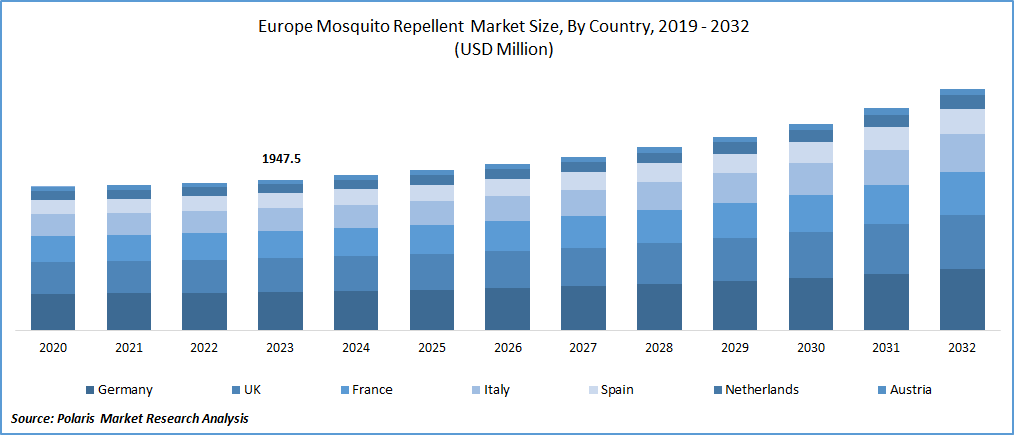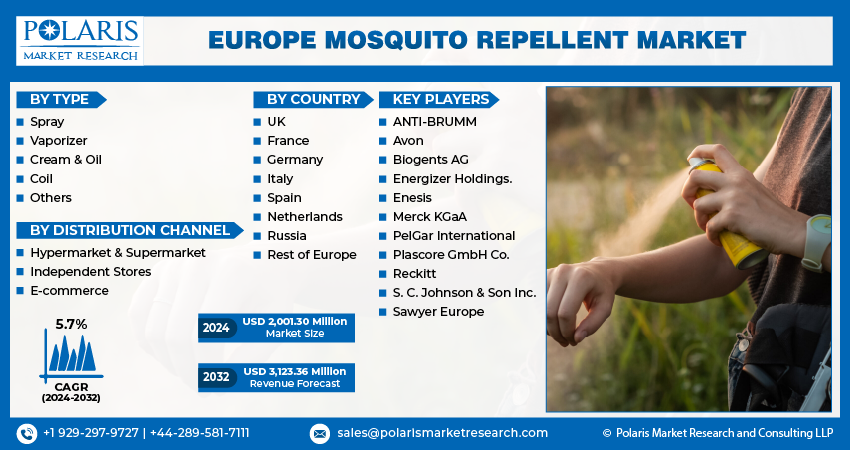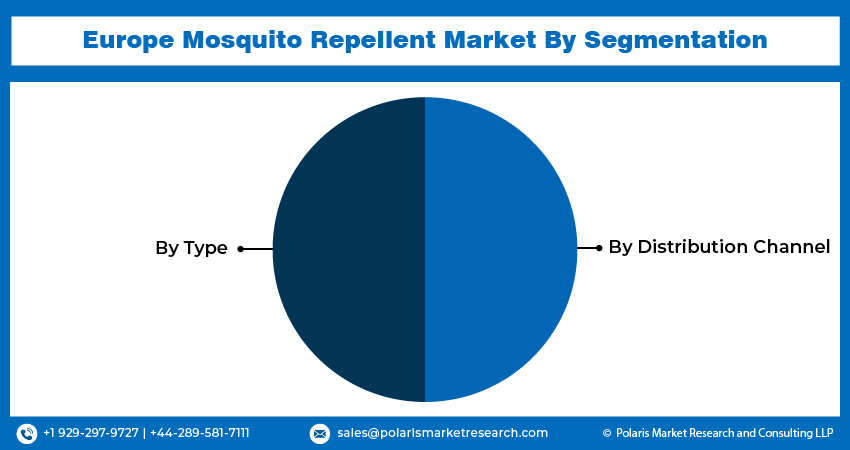
Europe Mosquito Repellent Market Share, Size, Trends, Industry Analysis Report, By Type (Spray, Vaporizer, Cream & Oil, Coil, Others); By Distribution Channel; By Country; Segment Forecast, 2024 - 2032
- Published Date:May-2024
- Pages: 115
- Format: PDF
- Report ID: PM4898
- Base Year: 2023
- Historical Data: 2019-2022
Report Outlook
Europe Mosquito Repellent market size was valued at USD 1,947.53 million in 2023. The market is anticipated to grow from USD 2,001.30 million in 2024 to USD 3,123.36 million by 2032, exhibiting the CAGR of 5.7% during the forecast period.
Industry Trends
The Europe Mosquito Repellent market has witnessed significant growth in recent years, driven by a number of variables, such as consumer preferences, regulatory requirements, health concerns, and climatic circumstances. The market includes a broad variety of goods, such as electronic gadgets, patches, creams, lotions, and sprays. Over the years, the market for insect repellent in Europe has grown steadily. The market is expanding as a result of variables such as shifting climatic conditions, an increase in mosquito-borne illnesses, and a rise in outdoor living culture. The size of the population, the frequency of mosquitoes, and customer awareness all affect market size.
Europe has a varied climate, which includes warm summers and humid conditions; mosquitoes thrive in Europe. As a result, there is a constant need for mosquito repellant in the entire area. As a result, customers are more conscious of the significance of shielding oneself from mosquito bites. Tight laws governing the effectiveness and safety of repellents for mosquitoes spur market innovation and product development. To ensure consumer safety, regulatory agencies such as the European Chemicals Agency (ECHA) of the European Union and national health authorities set criteria for product labeling and active ingredients.

To Understand More About this Research:Request a Free Sample Report
A shift in customer tastes toward natural and environmentally friendly goods has resulted in the emergence of botanical-based. Despite the growth prospects, the market is facing challenges like the complexity associated with deploying and managing Mosquito Repellent infrastructure. Setting up Mosquito Repellent nodes at distributed locations requires careful planning, coordination, and investment in networking, security, and management tools.
The market for insect repellents often varies with the seasons, peaking in the warmer months when mosquito activity is at its highest and falling in the cooler months. Changes in disposable income and economic downturns can impact consumer expenditure on non-essential items like mosquito repellant. Alternative solutions that offer different methods of mosquito protection, like citronella candles, electronic insect traps, and mosquito netting, compete with the market.
The European market for mosquito repellent is expanding steadily due to factors such as changing customer tastes, health concerns, climatic circumstances, and regulatory requirements. Notwithstanding obstacles including seasonal variations in demand and rivalry from substitute products, the market keeps developing and growing to satisfy the wide range of customers' demands in the area.
Key Takeaways
- Germany dominated the market and contributed over 5.6% of the market share.
- By type category, the cream and oil segment accounted for the largest Europe Mosquito Repellent market share.
- By distribution channel category, the independent stores segment dominated the market and e-commerce segment is anticipated to grow with a lucrative CAGR over the Europe Mosquito Repellent market forecast period.
What are the market drivers driving the demand for market?
Climate and environmental factors drive the European mosquito repellent market growth.
Climate and environmental factors drives the growth of mosquito repellents in Europe as the European countries are said to have variations in climate. There is a greater need for repellents in areas where mosquito breeding is encouraged by warmer temperatures and higher humidity. The need for repellents is fueled by the increasing number of parks, gardens, and water bodies along with the fast pace of urbanization. The geographic range of mosquitoes is being expanded by rising global temperatures and shifting weather patterns, which means that formerly unaffected places must use more repellant. Customers are looking for eco-friendly repellant solutions, like those derived from natural substances or sustainable packaging, as environmental issues become more and more of a concern. Cases of diseases spread by mosquitoes, such as the Zika or West Nile viruses, increase public awareness and encourage preventative actions, such as wearing repellents for personal safety.
Which factor is restraining the demand for market?
Environmental and sustainability concerns affect the European market growth.
Mosquito repellents can harm environmental sustainability in European countries through several channels by the widespread use of chemical-based repellents containing substances like DEET and permethrin can lead to water contamination and harm aquatic ecosystems when washed off into rivers and lakes. Additionally, the production and disposal of non-biodegradable plastic packaging contribute to pollution and waste accumulation. Furthermore, indiscriminate use of repellents may disrupt local insect populations, including beneficial species, and harm biodiversity. Finally, reliance on single-use products can exacerbate the carbon footprint through manufacturing and transportation processes. As a result, there is a growing push for more sustainable repellent alternatives, such as plant-based formulations and refillable packaging, to mitigate these environmental impacts. Naturally extracted plant-based essential oils such as eucalyptus and citronella oils are applied in the formulation of the composition of mosquito repellents to make them more environment-friendly and skin-sensitive.

Report Segmentation
The market is primarily segmented based on type, distribution channel, and country.
|
By Type |
By Distribution Channel |
By Country |
|
|
|
To Understand the Scope of this Report:Speak to Analyst
Category Wise Insights
By Type Insights
Based on application analysis, the market is segmented into spray, vaporizer, cream & oil, coil, and others. The Cream & Oil segment has dominated the market and is experiencing the fastest growth with a healthy CAGR in Europe’s mosquito repellent market. Creams, along with oil, either conceal the odor of human skin or deter mosquitoes. These include natural plant-derived oils like citronella or eucalyptus to establish a protective shield that hinders mosquitoes from sensing and alighting on the skin. These essential oils offer a broad spectrum of health advantages, encompassing decongestant, anti-inflammatory, antispasmodic, antiseptic, antifungal, antimicrobial, antiviral, and antibacterial properties. Its anti-inflammatory properties are frequently utilized in topical products to provide relief for achy muscles. Hence, the combination of cream & oil is most widely used in mosquito repellants.
By Distribution Channel Insights
Based on distribution channel analysis, Europe’s mosquito repellent market is segmented into hypermarkets & supermarkets, independent stores, and e-commerce. The independent stores held the largest market share in Europe’s mosquito repellent market, and the e-commerce segment is anticipated to grow at the fastest CAGR over the forecast period. The extensive range of products available serves as the key competitive edge for independent retailers, ensuring easy access to a wide variety of products for their customers.
E-commerce is widely being accepted by the people owing to its faster and more convenient options allowing customers “beyond trade” activities by granting budget-conscious options along with creating shopping experience memories for the customers. According to Forbes, In Germany, individuals exhibit a positive inclination towards shoptainment, while simultaneously displaying a keen interest in brand narratives and comprehending the manufacturing process and underlying values of a product.

Country-wise Insights
Germany
Germany leads the Mosquito Repellent market in Europe. The country's warm summers with lots of humidity are perfect for mosquito reproduction. Germans spend a lot of time outdoors, camping, hiking, and having barbecues, which increases their exposure to mosquitoes. Due to their preference for environmentally responsible remedies, natural repellents like citronella and essential oils are widely used in Germany. The mosquito repellent market in Germany is strong, with a large selection of products to suit various needs and tastes.
Competitive Landscape
The competitive landscape for the European mosquito repellent market is characterized by intense competition among key players striving to gain market share and differentiate themselves through innovation and collaborations. Research and development take place to finalize a suitable composition and formulation for mosquito repellent solutions tailored to consumers' needs. Amidst this landscape, composition for sustainable mosquito repellents in various forms, along with addressing evolving customer demands, is on the rise in the European mosquito repellent market.
Some of the major players operating in the European market include:
- ANTI-BRUMM
- Avon
- Biogents AG
- Energizer Holdings.
- Enesis
- Merck KGaA
- PelGar International
- Plascore GmbH Co.
- Reckitt
- S. C. Johnson & Son Inc.
- Sawyer Europe
Recent Developments
- In June 2023, The EVO REPEL mosquito repeller launched the Mosquito Repeller Lantern, a rechargeable, three-in-one accessory perfect for avid campers, hikers, and outdoor enthusiasts. It is equipped with an IPX4 rating to ensure water resistance and includes a 3,000-lumen lantern for illuminating dark areas. Additionally, it functions as a power bank, allowing users to charge their mobile devices on the go conveniently.
- In May 2023, Cutter Insect Repellent introduced an innovative strategy to combat mosquitoes through the utilization of the Zone Mosquito Repellent Device. This device consistently emits insect repellent, forming an invisible barrier that safeguards against mosquitoes.
Report Coverage
The Europe mosquito repellent market report emphasizes on key countries across the region to provide better understanding of the product to the users. Also, the report provides market insights into recent developments, trends and analyzes the technologies that are gaining traction around the region. Furthermore, the report covers in-depth qualitative analysis pertaining to various paradigm shifts associated with the transformation of these solutions.
The report provides detailed analysis of the market while focusing on various key aspects such as competitive analysis, component, application, organization size, vertical, and their futuristic growth opportunities.
Europe Mosquito Repellent Market Report Scope
|
Report Attributes |
Details |
|
Market size value in 2024 |
USD 2,001.30 Million |
|
Revenue forecast in 2032 |
USD 3,123.36 Million |
|
CAGR |
5.7% from 2024 – 2032 |
|
Base year |
2023 |
|
Historical data |
2019 – 2022 |
|
Forecast period |
2024 – 2032 |
|
Quantitative units |
Revenue in USD Million and CAGR from 2024 to 2032 |
|
Segments covered |
By Type, By Distribution Channel, By Country |
|
Customization |
Report customization as per your requirements with respect to countries, region and segmentation. |
FAQ's
Europe Mosquito Repellent Market Size Worth USD 3,123.36 Million By 2032
The top market players in Europe Mosquito Repellent Market are Avon, Biogents AG, Energizer Holdings, Enesis, Merck KGaA, PelGar International
Europe Mosquito Repellent market exhibiting the CAGR of 5.7% during the forecast period.
Europe Mosquito Repellent Market report covering key segments are type, distribution channel, and country.
